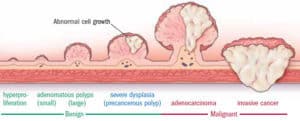Contents:
- Medical Video: 5 common signs of colon cancer
- How the normal digestive system works
- Development of colon cancer in the body
- What are the effects of colon cancer on the health of the digestive system?
- Types of colon cancer
- Adenocarcinoma
- Carcinoid tumor
- Gastrointestinal Stromal (GIST) Tumor
- Lymphoma
- Sarcoma
Medical Video: 5 common signs of colon cancer
Colorectal cancer is a term used to refer to cancer that starts from the large intestine to the rectum (anus). This cancer can also be referred to as colon cancer or rectal cancer separately, depending on where the cancer starts. What is the impact of colon cancer on the health of the digestive system? Here's the explanation.
How the normal digestive system works
The large intestine and rectum are part of the digestive system. The first part of the digestive system (stomach and small intestine) processes food as energy, while the last part (large intestine and rectum) absorbs liquid to form solid impurities which are then removed from the body.
After chewing and swallowing, food moves from the esophagus to the stomach. This is where food is partially decomposed and then sent to the small intestine, also called the small intestine. The intestine is called small because it is narrower than the large intestine (colon and rectum), but the small intestine is actually the longest part of the digestive system - about 6 meters long. The small intestine functions to continue the decomposition of food and absorb most nutrients, which are then circulated throughout the body.
The small intestine connects to the large intestine in the lower right abdomen. Most of the large intestine consists of muscular canals with a length of about 1.5 meters. Colon absorbs water and salt from food waste and serves as a storage place for dirt residue.

The colon (colon) has 4 parts:
- The first part is called ascending colon. This section begins with a small sac (cecum) in which the small intestine is connected to the colon and extends upward on the right side of the abdomen. Cecum is also the place where the appendix is connected to the colon.
- The second part is called transverse colon because it stretches from the right side to the left upper abdomen.
- The third part, called descending colon, keep extending down on the left side.
- The fourth and final part is called sigmoid colon because the shape resembles the letters "S" or "sigmoid."
The remaining food substances left after passing through the colon are called feces or feces. This dirt is transported and stored in the rectum, in the last 15 cm from the digestive system until the time is released from the body through the anus.
The walls of the large intestine and rectum are formed from several layers. Colorectal cancer starts in the deepest layer and can grow through some or all of the other layers. The extent of the spread of colon cancer will depend on how deeply the cancer grows into these layers.
Development of colon cancer in the body
Most colon cancer develops slowly for several years. Before cancer develops, tissue growth or tumor usually starts as a non-cancerous polyp in the wall in the large intestine or rectum.

The tumor is abnormal tissue and can be benign (not cancer) or malignant (cancer). Polyps are benign non-cancerous tumors. Some polyps can turn cancerous, but not all of them. The possibility of changing polyps into cancer depends on the type of polyp itself. There are two main types of polyps:
- Adenomatous polyps / adenomas (second image from the left) are polyps that can turn into cancer. Therefore, adenomas are referred to as pre-cancerous conditions.
- Hyperplastic polyps and inflammatory polyps, in general, are not pre-cancerous. However, some doctors think that some hyperplastic polyps can be pre-cancerous or can be a sign of an increased risk of adenoma and cancer, especially if these polyps grow in the ascending colon.
Another type of pre-cancerous condition is called dysplasia (fourth image from the left from the illustration above). Dysplasia is an area in the wall of the large intestine or rectum where cells look abnormal, but not like the actual cancer cells, when viewed with a microscope. These cells can turn into cancer over time. Dysplasia is usually found in people who have had diseases such as ulcerative colitis or Crohn's disease for years. Both ulcerative colitis and Crohn's disease cause chronic inflammation of the large intestine.
What are the effects of colon cancer on the health of the digestive system?
If polyps form, cancer can eventually begin to develop into the walls of the large intestine or rectum. When on the wall, cancer cells can then penetrate into blood vessels or lymph vessels. Lymph vessels are thin and small channels that carry dirt and liquid. These channels first flow to the lymph nodes, which are peanut-shaped structures that contain immune cells that help fight infection.
Once spread into blood vessels or lymph vessels, cancer cells can move to the nearest lymph nodes or other parts of the body, such as the liver. When cancer spreads to distant parts of the body, this is called metastasis.
Types of colon cancer
Some types of cancer can start in the large intestine or rectum, for example:
Adenocarcinoma
More than 95% of colorectal cancers are adenocarcinoma cancers. This cancer starts in cells that form mucus-producing glands to lubricate the walls in the large intestine and rectum. When doctors talk about colon cancer, this is what they almost always mean.
Carcinoid tumor
This tumor starts from special hormone producing cells in the intestine.
Gastrointestinal Stromal (GIST) Tumor
This tumor starts from special cells in the wall of the large intestine called interstitial cells from Cajal. Some are benign (non-cancerous), and others are malignant (cancer). These tumors can be found in any part of the digestive system, but are rarely found in the large intestine.
Lymphoma
Lymphoma is a type of cancer that affects immune system cells, which usually starts in the lymph nodes. Lymphoma can also begin in the large intestine, rectum, or other organs.
Sarcoma
Sarcomas are a type of tumor that can be started in blood vessels, muscles, and connective tissue in the walls of the large intestine and rectum. Colon sarcoma or rectal sarcoma is a rare type of cancer.
Hello Health Group does not provide medical advice, diagnosis or treatment.












